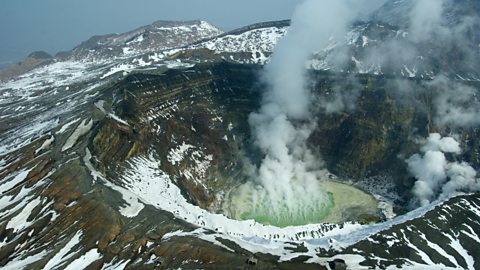Structure of the Earth
The Earth is made up of four distinct layers:
- The crustThe thin layer that is the outermost section of the earth. It varies from between 5 ÔÇô 70 km in depth and is broken up into several large pieces of rock which are known as plates. is the outer layer of the earth. It is a thin layer between 5-70 km thick. The crust is the solid rock layer made of large slabs called plates. These form both the ocean floor and the continents.
- The mantleThe mantle is the thickest layer of the earth (at 2,900 km) and is made up of silicate rocks that due to the high temperatures, causes the rocks to remain molten and to flow and move about. is the largest section, containing 84% of the EarthÔÇÖs volume. It has a diameter of 2,900 km. The mantle is mostly formed of solid rock, but it can deform slowly transferring heat and material.
- The outer coreThe liquid layer that surrounds the inner core. The outer core is 1,200 km deep is the layer surrounding the inner core. It is a liquid layer, also made up of iron and nickel. It is still extremely hot, with temperatures similar to the inner core.
- The inner coreThe centre of the earth with temperatures of over 5,500´é░C, where scientists believe that the material here is much more dense than material at the crust. It is around 2,200km deep. is in the centre and is the hottest part of the Earth. It is solid and made up of iron and nickel with temperatures of up to 5,500┬░C. With its immense heat energy, the inner core is like the engine room of the Earth.
The diagram below shows the structure of the earth. In geography, taking a slice through a structure to see inside is called a cross section.
The crust and plates
There are two different types of crustThe thin layer that is the outermost section of the earth. It varies from between 5 ÔÇô 70 km in depth and is broken up into several large pieces of rock which are known as plates.: continental crust: which carries land, and oceanic crust, which carries water.
Continental plates are usually quite thick (between 35 to 70 km) compared to the much thinner oceanic plates (between 5 and 10 km).
The oceanic rocks are usually much younger than the continental rocks as new plate material is still being made at theseplate boundariesThe region where two or more tectonic plates meet. It is a zone of intense seismic activity..
The oceanic rocks are usually made from basalt, while continental rocks are made from granite.
Continental and oceanic plates all fit together to form the outer crust of the planet. Eight major plates are named on the diagram below.
Convection currents and plate movement
The Earth's crustThe thin layer that is the outermost section of the earth. It varies from between 5 ÔÇô 70 km in depth and is broken up into several large pieces of rock which are known as plates. is broken up into pieces called plates.
These plates move due to convection currents in the mantleThe mantle is the thickest layer of the earth (at 2,900 km) and is made up of silicate rocks that due to the high temperatures, causes the rocks to remain molten and to flow and move about..
Heat from the core makes magma in the mantle rise towards the crust. As the hot current nears the crust, it begins to cool and sink back towards the core. As the magma sinks, it drags the plates across the surface of the Earth.
The movement of the plates, and the activity inside the Earth, is called plate tectonicsThe large sections of rock which make up the crust of the earth. These are divided into contintental plates which are usually thick plates that form at land masses and oceanic plates which are thinner and form at the bottom of ocean floors..
The point where two plates meet is called a plate boundariesThe region where two or more tectonic plates meet. It is a zone of intense seismic activity..
Where convection currentThe motion of a liquid or gas caused by heating some part of that liquid or gas. move plates apart, constructive plate boundaries (margins) are formed.
Where convection currents push plates together, destructive plate boundaries (margins) are formed.
Plate tectonics cause earthquakeA fault rupture that generates seismic waves. This occurs when rocks on either side of a weakness in the earthÔÇÖs crust ( a fault) causes the ground to vibrate and shake. and volcanoA volcano is a vent in the ground which is caused by the upward movement of magma through cracks in the rock..Earthquakes and volcanoes are most likely to occur either on or near plate boundaries.
Formation of landforms at plate margins
Constructive plate margin
constructive plate marginAn area where two tectonic plates are moving away from one another. are where tectonic plates pull apart due to convection currents in the mantle. Most constructive plate boundaries are found on ocean floors.
As the plates move apart (very slowly), magmaMolten rock that is found within the Earth. rises from the mantle to fill the gap.
This is also accompanied by earthquakes.
When the magma reaches the surface, it cools and solidifies to form a new crust of igneous rockIgneous rocks are those which have been formed by the cooling and solidification of molten rock (magma) from underneath the earthÔÇÖs crust.. At constructive plate boundaries, mid-ocean ridges will be formed.
A mid-ocean ridge is an underwater mountain chain of volcanoes built up after repeated eruptions at a constructive boundary, when the sea floor spreads apart, e.g. the Mid-Atlantic RidgeAn area of volcanoes in the centre of the Atlantic Ocean..
Some of these undersea volcanoes become so large that they erupt out of the sea to form volcanic islands, e.g. Surtsey and the Westman Islands near Iceland.
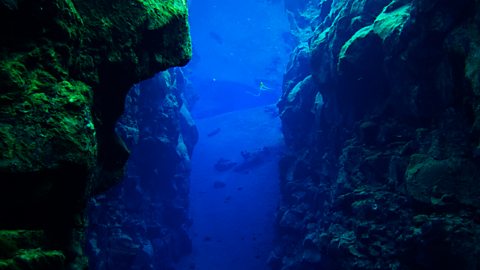
Destructive plate margin
At destructive plate marginThis happens where crustal plates move together and one is forced beneath the other., subduction zones and ocean trenches will be formed.
At a destructive boundary the plates are moving towards each other.
This usually involves a continental plate and an oceanic plate.
The oceanic plate is denser than the continental plate. As they move together, the oceanic plate is forced underneath the continental plate.
The point at which this happens is called the subduction zoneCaused at destructive plate margins where the oceanic plate is pushed underneath the continental plate. The movement of the plate downwards creates a subduction zone where huge amounts of friction mean that earthquakes take place..
When the oceanic plate is forced below the continental plate it melts to form magma and earthquakes are triggered. The plate melts due to friction and due to the heat from the mantle.
The magma collects to form a magma chamber.
This magma then rises up through cracks in the continental crust.
As pressure builds up, a volcanic eruption may occur causing composite cone volcanoes (e.g. Nevado del Ruiz in Colombia).
A major example of this plate movement is along the coastline of South America (at the Nazca and South American plate boundary).
At the point where the plate is forced down, there will be a deep gap under the sea which is known as an ocean trench. The deepest ocean trenchCaused at destructuve plate margins where the oceanic plate is forced underneath the continental plate and this creates a deep ocean trench where 2 plates meet. is the Mariana trench found in the western Pacific Ocean.
Fold Mountains, such as the Andes, are also found at destructive plate boundaries. They are formed due to the pressure of the two plates colliding, which forces the continental crust to crumple and push upwards along the western coastline of South America.
Collision zones
collision zoneA collision zone is where two continental plates move towards each other - this can cause fold mountains and earthquakes. are found at a special form of destructive boundary. They form where two continental plates are forced together by the convection currents in the upper mantle. At collision zones fold mountains will be formed.
- Where an area of ocean separates two plates, sediments will settle onto the ocean floor. Over millions of years these deep sediment layers are compressed, squeezing out water and forming sedimentary rockSedimentary rocks are those which have been formed due to sediments that have built up over a long period of time, usually under water..
- When the two continental plates move towards each other, the layers of sedimentary rock on the sea floor become compressed, crumpled and are folded upwards.
- Eventually this folded sedimentary rock may rise above sea level as a range of fold mountainThese are created when two continental plates are pushed towards each other - the sedimentary rock that is trapped in the middle will be folded higher and higher forming mountains. .
- The peak of Mt Everest (Sagarmatha), the worldÔÇÖs highest mountain is five miles above sea level. It is made of limestone rock that originally formed on the ocean floor that once lay between India and South Asia.
- Where the rocks are folded upwards, they are called anticlines. Where the rocks are folded downwards, they are called synclines.
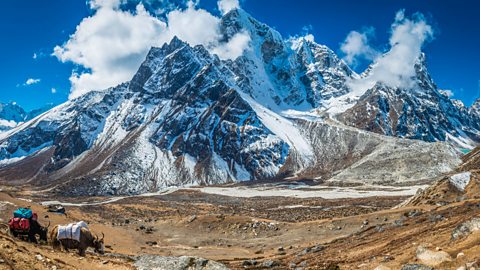
Conservative plate margin
At conservative plate marginAreas between two crustal plates that are moving past each other in opposite directions or at different speeds., fault linesWhere one plate meets another (also called a plate boundary). will be formed.
These are plate boundaries where two plates are either slipping past each other in opposite directions or at different rates in the same direction.
The plates do not move past each other smoothly.
There will often be a build-up of friction or energy that is ultimately released as an earthquake.
A good example of this is along the San Andreas Fault where the Pacific and the North American plates are sliding past each other.
Watch: Plate tectonics video
Plate tectonics and the formation of landforms at plate margins.
Quiz: Take the test
More on The restless earth
Find out more by working through a topic
- count2 of 4
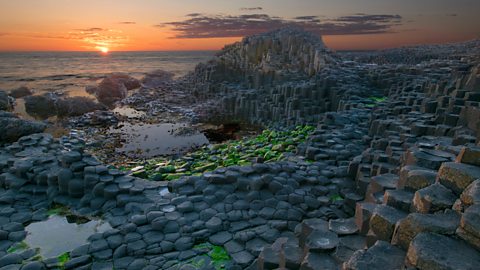
- count3 of 4
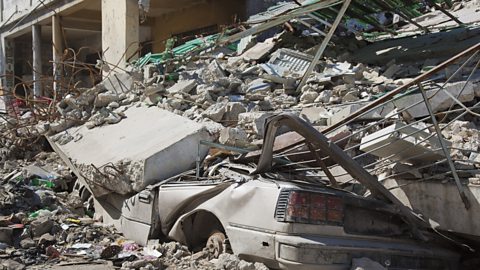
- count4 of 4
